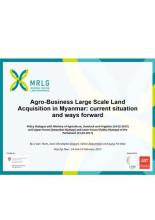Land Library Search
Through our robust search engine, you can search for any item of the over 73,000 highly curated resources in the Land Library.
If you would like to find an overview of what is possible, feel free to peruse the Search Guide.
/ library resources
Showing items 1 through 9 of 121.This presentation summarizes an on-going research in Myanmar, carried out by renowned agricultural specialist U San Thein and a team of experts, with the support of MRLG.
As the Ministry of Agriculture, Forestry, Fisheries (MAFF) aimed to finalize in the end of 2016 the draft law on agricultural lands that is currently in 6th draft, MRLG, together with other partners, has supported the NGO Forum on Cambodia to mobilize representatives of farmer organizations and C
This short video examines an initiative by Earth Systems to develop a tea sector dialogue platform that brings together key stakeholders in the value chain to jointly examine challenges and opportunities for the development of a more equitable and sustainable tea sector in Laos.
This country level analysis addresses land governance in Viet Nam in two ways.
Protected area management is threatened by weak articulation between the goals for conservation, national development and local livelihoods. This discussion note examines the competing interests for lands inside Cambodian Protected Areas and makes suggestions for policy considerations.
The inspiration for this sourcebook came from a 2014 meeting of researchers, practitioners and policy makers in Addis Ababa under the auspices of an event co-convened by the Global Water Initiative East Africa (GWI EA), the International Water Management Institute (IWMI) and the Water, Land and E
This is a desk appraisal of the Alliances for Religions and Conservations (ARC) done for the Norwegian Agency for Development Cooperation (Norad) by the Department of International Environment and Development Studies, Noragric, at the Norwegian University of Life Sciences (NMBU).
Professor Kjell Havnevik is retiring from the Nordic Africa Institute (NAI) in 2015.
For cities to be sustainable, they need to simultaneously address the vulnerability of people, places and sectors that may be affected by a changing climate; mitigate their greenhouse gas (GHG) emissions; and ensure adequate access to basic urban services such as water, food and energy to their g






